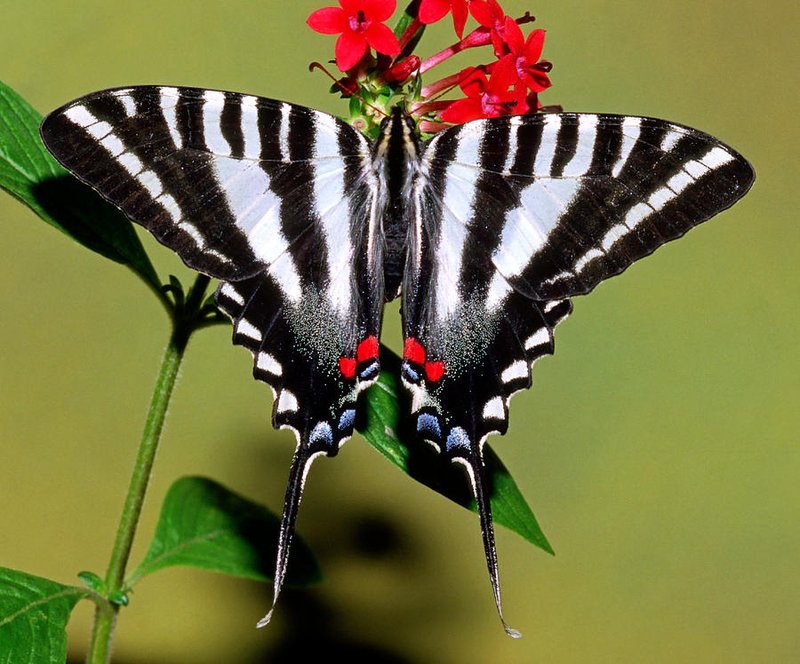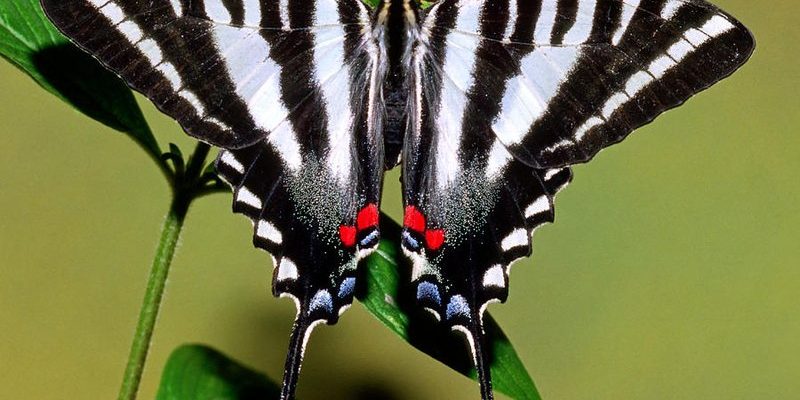
The Zebra Swallowtail Butterfly is one of those creatures that catches your eye and makes you smile. Imagine a delicate, flying piece of art with bold black and white stripes, fluttering gracefully among the flowers. This striking butterfly isn’t just beautiful; it’s also fascinating when you dive into its world. Often seen gliding through gardens and wooded areas, the Zebra Swallowtail is a true symbol of natural beauty.
But what makes these butterflies so special? For starters, their striking appearance is just the beginning. They have unique behaviors, specific habitats, and a fascinating life cycle that many might not know about. If you’re curious about what makes Zebra Swallowtails tick, you’re in for a treat. Let’s explore their world and uncover the secrets behind these remarkable insects.
Physical Characteristics
The Zebra Swallowtail Butterfly is easily recognizable thanks to its bold, striped pattern. Typically, adults have black wing edges that contrast beautifully with white or pale yellow stripes. These vivid colors aren’t just for show—they serve as a warning to potential predators. The butterfly’s striking appearance signals that it might not be a tasty meal due to its diet of toxic plants when it was a caterpillar.
In terms of size, Zebra Swallowtails boast a wingspan of about 3 to 4 inches, which is fairly standard for butterflies. The male and female butterflies exhibit slight variations in coloration; males tend to be darker and more vibrant, while females have a softer look. This color variation can sometimes help you identify their sex, especially when you see them fluttering about.
Interestingly, these butterflies also have tails on their hindwings, giving them a unique swallowtail shape. This feature not only contributes to their namesake but also aids in flight. The tails can disrupt airflow and create a confusing pattern for predators, enhancing their chances of escape if threatened.
Habitat and Distribution
Zebra Swallowtail Butterflies are primarily found in parts of North America, with a range that includes eastern and central regions. They thrive in various environments, including open fields, gardens, and forest edges. Their adaptability to different habitats is one of the reasons they flourish in many areas.
One of the key requirements for these butterflies is a source of their host plants, which are essential for their lifecycle. They are particularly fond of the pawpaw tree, which is where female butterflies lay their eggs. This is interesting because it reflects their reliance on specific plants for survival. In more urban settings, they can often be seen flitting around gardens and parks, as long as their host plants are nearby.
Overall, their distribution stretches from the southeastern U.S. to parts of Canada during the warmer months. As temperatures drop, they migrate to warmer areas or enter a state of dormancy, making them seasonal visitors in many locations. So, if you’re lucky enough to spot one in your garden, consider yourself fortunate!
Diet and Feeding Habits
The diet of the Zebra Swallowtail Butterfly is primarily nectar from various flowers, but they have specific preferences. They’re particularly fond of blossoms from plants such as milkweeds, wildflowers, and the pawpaw tree they rely on during their caterpillar stage. This diverse eating habit not only sustains them but also makes them key players in pollinating many plants.
Butterflies typically use their proboscis—a long, straw-like mouthpart—to sip nectar from flowers. It’s fascinating to watch them in action, gracefully hovering near blossoms and delicately feeding. This feeding behavior plays a crucial role in ecosystems as it helps fertilize plants, promoting growth and biodiversity.
Interestingly, while Zebra Swallowtails favor nectar, their caterpillars initially feed on the leaves of host plants, particularly the pawpaw. These leaves are nutritious yet toxic, which allows the caterpillars to gain some protection from predators. It’s a clever survival strategy that carries over into adulthood, as their bright colors signal danger to potential threats.
Life Cycle and Behavior
The life cycle of the Zebra Swallowtail Butterfly is a fascinating journey that showcases the wonders of nature. Like all butterflies, they undergo complete metamorphosis, with four distinct stages: egg, larva (caterpillar), pupa (chrysalis), and adult. It all begins when a female lays small, round eggs on the leaves of host plants, especially the pawpaw tree.
After a few days, the eggs hatch into caterpillars that are initially quite small and very hungry. These caterpillars grow quickly, shedding their skin multiple times in a process called molting. It can be quite a sight to see them munching away, and they often become quite plump as they prepare for the next stage of their life.
Once they reach a sufficient size, the caterpillars find a suitable spot to form a chrysalis. During this stage, they undergo a radical transformation. Inside the chrysalis, the caterpillar is restructured into a butterfly. This stage can last from a few weeks to several months, depending on environmental conditions. Finally, the adult butterfly emerges, ready to take flight and continue the cycle.
Threats and Conservation
While the Zebra Swallowtail Butterfly is beautiful, it faces numerous threats in today’s world. Habitat loss due to urban development and agriculture poses significant challenges. As gardens and natural areas shrink, these butterflies find it harder to locate essential host plants, which are critical for their survival.
Additionally, pesticides and pollution negatively impact butterfly populations. Chemical exposure can harm their delicate bodies and disrupt their lifecycle. It’s heartbreaking to think about how these vibrant creatures are affected by human actions, reminding us all of our responsibility towards nature.
Conservation efforts are vital for the Zebra Swallowtail Butterfly. Local communities can play a significant role by planting native flowers and host plants in their gardens. By creating friendly habitats, you contribute to the survival of these beautiful butterflies while also enhancing your own local ecosystem. Every little effort counts and can lead to a profound impact over time.
Interesting Facts About Zebra Swallowtail Butterflies
| Wingspan: | 3 to 4 inches |
| Diet: | Nectar and pawpaw leaves |
| Habitat: | Woodlands, gardens, and fields |
| Life Span: | Approximately 10-14 days as adults |
| Coloration: | Black and white striped wings |
| Migration: | Seasonal movements to warmer areas |
The Zebra Swallowtail Butterfly is not just another pretty face in the garden; it embodies the beauty and fragility of our natural world. From its striking appearance to its critical role in ecosystems, understanding and appreciating these butterflies can inspire us to take action in conserving their habitats. So next time you spot one fluttering by, take a moment to enjoy the wonder of nature and remember the challenges these butterflies face.
FAQ
What is the Zebra Swallowtail Butterfly’s primary diet?
The Zebra Swallowtail Butterfly primarily feeds on nectar from a variety of flowers. While they enjoy many types of blossoms, they have a particular affinity for milkweeds and wildflowers. As caterpillars, they feed on the leaves of the pawpaw tree, which is crucial for their development during the larval stage. This diverse diet not only sustains them but also contributes to pollination in their habitats.
Where can you typically find Zebra Swallowtail Butterflies?
Zebra Swallowtail Butterflies are found predominantly in eastern and central North America. They inhabit diverse environments such as open fields, gardens, and edges of woodlands. They are often spotted in areas where their host plants, particularly pawpaw trees, are abundant. This enables them to thrive in both rural and urban settings, making them a beautiful sight to behold.
Are Zebra Swallowtail Butterflies harmful to plants?
No, Zebra Swallowtail Butterflies are not harmful to plants. In fact, they play a vital role in pollinating various flowering plants, contributing to their growth and reproduction. While their caterpillars do feed on the leaves of specific plants, this is part of a natural cycle that allows the butterfly population to thrive. The presence of these butterflies can indicate a healthy ecosystem.
What threats do Zebra Swallowtail Butterflies face?
Zebra Swallowtail Butterflies face several threats, primarily habitat loss due to urbanization and agricultural practices. Pesticides and pollution also pose risks to their populations. These factors can disrupt their lifecycle and make it difficult for them to find suitable habitats and food sources. Raising awareness and participating in conservation efforts can help protect this beautiful species.
How long do Zebra Swallowtail Butterflies live?
As adults, Zebra Swallowtail Butterflies typically have a lifespan of about 10 to 14 days. However, depending on environmental conditions and availability of food, they might live longer or shorter. Their lifecycle includes several stages, with the larval and pupal phases lasting longer than the adult stage. Understanding their lifecycle stages helps illustrate the time it takes for them to develop from egg to butterfly.
Do Zebra Swallowtail Butterflies migrate?
Yes, Zebra Swallowtail Butterflies do migrate! During colder months, they often relocate to warmer areas to escape harsh conditions. This seasonal movement ensures their survival, especially in regions that experience a significant drop in temperature. In spring, they return to their original habitats to reproduce and continue their lifecycle.
What can I do to attract Zebra Swallowtail Butterflies to my garden?
To attract Zebra Swallowtail Butterflies, consider planting native flowers and host plants such as pawpaw trees in your garden. Providing a variety of nectar-rich flowers will help draw them in while offering caterpillars a safe place to develop. Creating a butterfly-friendly environment with plenty of sun and water sources will encourage them to visit and thrive in your space.
Are there any conservation efforts for Zebra Swallowtail Butterflies?
Yes, several conservation efforts are in place to protect Zebra Swallowtail Butterflies. Local communities and organizations are working to promote awareness about the importance of preserving natural habitats and planting native species. Individual actions, like creating butterfly gardens, can significantly contribute to the survival of these butterflies and enhance biodiversity in your area.
What is unique about the Zebra Swallowtail Butterfly’s appearance?
The most striking feature of the Zebra Swallowtail Butterfly is its bold black and white striped pattern, resembling the stripes of a zebra. Their hindwings also feature long tails, giving them a unique swallowtail shape that aids in flight. This distinct appearance not only catches the eye but serves as a warning to predators about their potential toxicity due to their caterpillar diet.
How do Zebra Swallowtail Butterflies contribute to their ecosystem?
Zebra Swallowtail Butterflies play a crucial role in their ecosystem as pollinators. By feeding on nectar from various flowers, they transfer pollen from one bloom to another, aiding in plant reproduction. This interaction is vital for maintaining healthy ecosystems and promoting biodiversity, showcasing the interconnectedness of all life forms.
Can I raise Zebra Swallowtail Butterflies at home?
Yes, you can raise Zebra Swallowtail Butterflies at home! To do this, you’ll need to start with eggs or caterpillars, ideally collected from the wild or obtained from a reputable source. Providing the appropriate host plants, like pawpaw, and a suitable habitat will help ensure their survival. Observing their growth and transformation can be a delightful educational experience for both children and adults.

